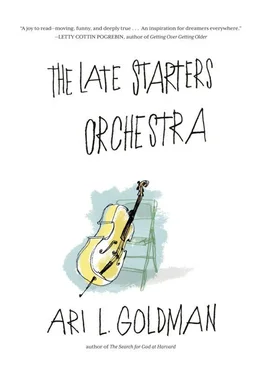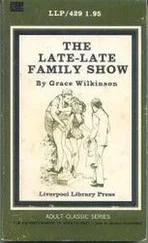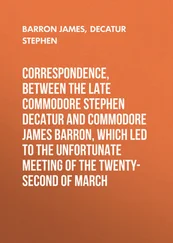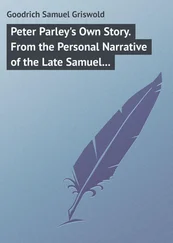“And what about ‘The English Country Garden’?” I asked Chris.
“It took me five years, but I think I finally nailed it,” she said. On the violin.
People like Colin, Ed, and Chris made me feel as though I belonged.
Unlike Ed, I had played a flat before. And unlike Colin, I did my practicing in one of the soundproof practice rooms. I spent a good hour a day practicing, which was not nearly enough, but then I had a very tight schedule.
The day began at 7:30 a.m. with something called “low-impact yoga for musicians” taught by a short and compact double bassist named Victor, one of the gypsy-music instructors. Here was definitely something Shira would enjoy, so the two of us arrived early, unrolled our yoga mats, and assumed the lotus position in front of Victor.
“Playing music here is like binge drinking,” Victor began. “How long do you normally practice a day?” he asked us. “Twenty minutes? Thirty minutes? Well, here you are playing for eight hours a day. It is a shock to the system! You have to be prepared.”
Victor, who looked like he’d been up all night — and probably was, playing gypsy music around the campfire — showed us some quick exercises that cellists can do, as he put it, “while the conductor is yelling at the violinists.” The exercises involved a lot of neck rolling and pivoting in one’s chair and slapping one’s back. “This is like an internal massage,” he said. Afterward, Victor demonstrated “relaxation techniques,” including lying on the floor on a yoga mat supported by pillows and bolsters. Victor promptly fell asleep. We waited awhile for him to wake, but then realized that he was catching up on his sleep. Shira and I quietly wandered off to breakfast.
After eating, we were divided up into technique sections. Shira took off to a special program for anyone interested in painting. I was assigned to a cello section with a perfectly coiffed, smartly dressed, precise, and very proper British woman named Susannah. She could not have been more different than my rumpled and disorganized Mr. J. Your strings are tuned in perfect fifths, he’d say when he’d lose something or arrive late. I’m not.
A perfect fifth is the relationship between the four strings on the cello. The term means a tone that is five degrees above or below a given tone. And he taught me how to recognize one. Count, he’d instruct. Do, re, mi, fa, so, la, ti, do. The do and the so are a perfect fifth apart!
That is why if you can get your A string in tune, you can tune all the others. Just use your perfect fifths.
Most teachers will tune your A and leave the rest to you. But the precise Susannah wouldn’t settle for that. Susannah insisted on listening to each of the four strings on each of our cellos and made the necessary adjustments. With ten people in the class that meant a considerable amount of time, but it made everyone feel special — and in tune. Susannah then went through some basic exercises that every cellist with even a modicum of training knows: playing scales, holding the bow, stretching for what are called the extended positions. Still, Susannah gave me some new ways to think about playing. At one point she compared the moment when a cellist changes bow direction to “water lapping on the shore,” and at another point to “the artist’s paint brush, going back and forth, back and forth.” She spoke about holding the bow “with stability and flexibility,” noting that the proper position of the thumb and first finger were key. “Don’t grip the bow,” she counseled. “Let it flow through your fingers, supported by the strings.”
About three times the first hour, Susannah mentioned that her hands were small (for a cellist) and that she had to compensate in certain ways. This inspired one of my classmates, a man in his sixties named Jeremy, to recall a conversation between the great pianist Artur Schnabel and an admirer. “Mr. Schnabel,” the admirer said. “Your hands are so small. How do you play piano with such small hands?” To which Schnabel is said to have replied: “Madame, I don’t play with my hands.”
A great musician plays with heart and mind and soul.
In stark contrast to the well-appointed Susannah was the free-spirited Deirdre, who later in the day was in charge of my cello ensemble. To be fair, Deirdre was suffering from a head cold, but she seemed sort of spacey. Maybe she, too, had been up all night with Victor and the gypsy musicians. Her long blond hair was unkempt and she wore an oversized Indian print shirt over a pair of torn blue jeans. She was our hippie teacher, both in style and in spirit.
Deidre gave us a mighty A from her cello and sat back and listened to us tune. “Tuning is the beginning of playing. Listen to that sound! Wonderful! Wonderful!” All the A’s taken together did make quite a good sound. Deirdre assembled us in a circle, saying that we needed to listen to each other. Ensemble playing in this context meant music written for four cello parts. Since we were a group of eight, two cellists played each part. We warmed up with a piece by Haydn and then tried some Bach. We did our best — and sometimes got lost — but Deirdre was a forgiving coach. She minimized our mistakes and luxuriated in our successes. “Now hold that chord. Hold it. Hold it. Hold it. Perfection!”
After an hour, I again packed up my cello, folded my music stand, and found the room for the workshop on gypsy, Balkan, and klezmer music. At breakfast, when I last saw Shira, I urged her to come and sit in on this class. If part of my agenda was to involve her in classical music, this seemed like my best shot.
Shira arrived a few minutes late and sat in the back of the room near the piano. I set up my stand and cello in the front with a group of cellists. I gave her a wave and a smile to show that I was happy she came. Suddenly, a tall and rubber-limbed man — his name was Pietr, we would learn — came bounding into the room with his violin. There was no talk of tuning our instruments and, it turned out, no need for our music stands. “No sheet music now. No music,” Pietr said in a Polish accent, waving his bow at us. “You’ll get the music later.”
“For now, just listen. I am going to play by the air. You play, too, by the air.” Occasionally he would call out a series of notes: “G, C sharp, A,” he would shout. “It’s the gypsy rumba.”
“Play. Play. Play,” he said as he leapt around the room, and we did our best to follow. “Play. There are no wrong notes.” It was all by ear — or by “air,” as he put it — and soon we were making music. There was a set of bongo drums in the corner and he told one of the violinists to put down her violin and start banging. He started tapping on his violin with his bow and encouraged others. Shira was dancing in place.
“My wife plays piano,” I shouted to Pietr over the din. “Can she join?” Pietr nodded yes, and soon Shira was banging out chords, I was plucking notes, Pietr was carrying the melody, and a dozen other musicians were trying to keep up.
This went on for most of the hour until Pietr took one final leap, coming down as he bowed on his violin and we all laughed in amazement. He never did hand out any sheet music.
My wonder only increased when I saw that Shira had attracted a small group of musicians, including Victor, the yoga teacher, who brought his bass over to the piano when she started to play. Victor invited her to stay and jam with the next gypsy, Balkan, and klezmer session.
No one invited me. I looked at my schedule and saw that orchestra was next. Compared to the gypsy session, orchestra was a drag. It was back to the classics. The conductor was nice but colorless. I can’t even remember his name. And the music was rather unmemorable — Carl Nielsen, I think. Unlike the other groups, which were made up of eight to twenty musicians, we were an orchestra of one hundred. Everyone seemed uptight. I sat next to a diminutive older woman named Linda. We seemed evenly matched. Both of us were timid players, waiting for cues from the other cellists about stopping and starting. The conductor spent a lot of time yelling at the violinists. I recalled the exercises that Victor taught us for moments like this. When the conductor stopped yelling at the violinists, he yelled at the cellists. Finally the rehearsal came to an end. When it was over I said to Linda: “Nice meeting you. See you tomorrow.”
Читать дальше












